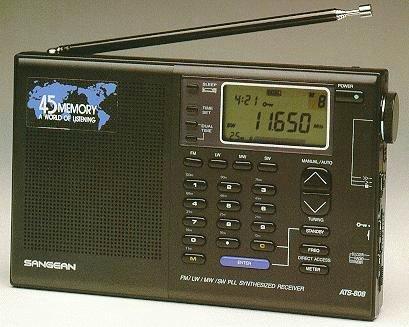
Year Introduced: 1991 (updated in 1994)
Power: 6 Volts DC for radio, 3 VDC for backup, optional AC adaptor
Size: 196 x 125 x 36 mm
Weight: 620 g without batteries Price: €138, US$120, CAN$190, £120, A$270
Coverage: LW, MW, SW 1621-26100 kHz, FM
Value Rating: 


This review was compiled independently. The Medium Wave Circle and Radio Netherlands has no financial connection with Sangean, the manufacturer of this receiver.
INTRODUCTION
When introduced in 1991, this set had a price tag in Europe of around #8356;135, and was designed to heavily compete with other “paperback book” size digital portables. The ATS-808A measures just 197 x 125 x 37 mm, and weighs 695 grams including the 6 penlight batteries (two of these are used to drive the on-board computer, the other four to run the radio).
The ATS-808A is designed for simple operation. It is for the reception of broadcast signals only. Although it has a stable PLL synthesizer, there is no provision for SSB (unlike on the more expensive Sony ICF-SW-7600 or Panasonic RFB-45). However, the ATS-808A has provision for two bandwidth filters, (6 and 2.7 kHz wide (-6dB), both with a fair shape factor for a receiver of this type.
Frequencies are shown on a LCD display that is easy to see in daylight. The memory channel number is shown in one corner of the display, the time (using 24 hr clock format) and the relevant metre-band elsewhere in the window. A simple “bar” style signal strength metre is also offered, although this was far too sensitive to be anything more than a rough indicator. At night you can’t see any of this information because there is no backlighting of the display. The radio has a timer, and a dual clock… that is useful if you want to keep track of the difference between UTC and local time.
COVERAGE
The ATS-808A covers 150-1620 kHz, 2300-29999 kHz, and 87.5-108 MHz. We have seen some versions where shortwave coverage stops at 26100 kHz. If you listen to the radio using headphones, then stereo reproduction on FM is possible. The tuning software has been well thought out. You can punch in the frequency on the keyboard. The keys are well spaced apart so that pushing two keys together by accident is almost impossible. However, unlike some radios that use a small raised dot on one key to help a visually disabled operator orientate his or herself, all the keys on the Sangean feel the same. You can also ask the radio to select a particular metre band if you cannot remember a particular frequency. The ATS-808A offers two means of manual tuning control.
Either a set of up-down buttons, or a manual rotary tuning knob at the side of the set. Depending on a switch setting, the tuning knob adjusts the tuning frequency by 1 kHz on AM (50 kHz on FM) or by 9/10 kHz on AM (100 kHz on FM). In Europe the radio should be set to jump in 9 kHz in the fast position, but this can be adjusted to the 10 kHz channel spacing. You can also lock the tuning system once you have found the channel you are looking for. Simple automatic bandscanning is also offered on this receiver.
PRE-PROGRAMMED MEMORIES
The radio offers 54 memory channels, nine each on LW, MW, 18 on shortwave and FM. An earlier version of the receiver had only 45 memories, but now there are two banks for FM. The first bank of 9 is selected by pressing a number of the keyboard. The next 9 are selected by pushing the “0” button first, then the chosen number. In Europe, Siemens of Germany distributes the Sangean radio under their own brand label (i.e. RK-661). Siemens have had 18 channels pre-programmed in the factory, all of them popular frequencies for German language programmes (e.g. Radio Austria International on 6155 kHz). A table on the back of the set tells you which channel represents which station and frequency. Some of the frequencies chosen are peculiar, but you can re-programme some or all of them yourself. The radio works best on its built-in telescopic whip. The dynamic range of the radio is fair, overloading during evening hours being reduced to acceptable levels by reducing the length of whip or switching the attenuator to the LOCAL position.
In short, the ATS-808A is a reasonable portable radio for the price. The features of the newer ATS-909 are also worth considering, especially if you find memory features useful. The ATS-808A is not a DX machine, and yet the two bandwidth possibilities makes it more than most portables in its price range.
This review first appeared on the Radio Netherlands website.